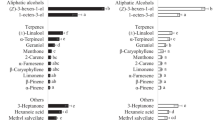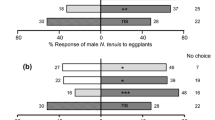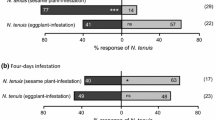Abstract
We studied the response of the predatory mite Amblyseius womersleyi collected in 13 different sites in Japan toward Tetranychus urticae-infested kidney bean leaf volatiles in a Y-tube olfactometer. The predatory mites were collected from eight plant species infested by one of three tetranychid mite species. The predators' responses to the infested-leaf volatiles varied from 33% to 97% among the populations. The predators collected at 10 sites showed a significant preference for infested-leaf volatiles, whereas those collected at three tea plantations did not distinguish between the infested- and uninfested-leaf volatiles. We discussed the possible factors that affected the olfactory response of A. womersleyi towards the infested leaf volatiles.
Similar content being viewed by others
References
Dicke, M. 1994. Local and systemic production of volatile herbivore-induced terpenoids: Their role in plant-carnivore mutualism. J. Plant Physiol. 143: 465-472.
Dicke, M. 1999. Are herbivore-induced plant volatiles reliable indicators of herbivore identity to foraging carnivorous arthropods? Entomol. Exp. Appl. 91: 131-142.
Dicke, M., Schütte, C. and Dijkman, H. 2000. Change in behavioral response to herbivoreinduced plant volatiles in a predatory mite population. J. Chem. Ecol. 26: 1497-1514.
Dicke, M., van der Maas, K. J., Takabayashi, J. and Vet, L. E. M. 1990. Learning affects response to volatile allelochemicals by predatory mites. Proc. Exp. Appl. Entomol. 1: 31-36.
Ehara, S. and Amano, H. 1998. A revision of the mite family Phytoseiidae in Japan (Acari, Gamasina), with remarks on its biology. Jap. Soc. Sys. Zool. 3: 25-73.
Hamamura, T. 1986. Studies on the biological control of kanzawa spider mite, Tetranychus kanzawai Kishida, by the chemical resistant predacious mite, Amblyseius longispinosus (Evans) in tea fields (Acarina: Tetranychidae, Phytoseiidae). Bull. Tea Res. Sta. 21: 122-197. in Japanese with English summary
Jeppson, L.R., Keifer, H.H. and Baker, E.W. 1975. Mites Injurious to Economic Plants. University of California Press, Berkeley.
Kawai, A. 1997. Prospect for integrated pest management in tea cultivation in Japan. JARQ. 31: 213-217.
Kawai, A., Kohata, K. and Yamaguchi, Y. 1999. Deposition of chemicals on various parts of tea bushes sprayed on the plucking surface. Appl. Entomol. Zool. 34: 387-389.
Maeda, T., Takabayashi, J., Yano, S. and Takafuji, A. 1999. Response of the predatory mite, Amblyseius womersleyi (Acari: Phytoseiidae), toward herbivore-induced plant volatiles: variation in response between two local populations. Appl. Entomol. Zool. 34: 449-454.
Maeda, T., Takabayashi, J., Yano, S. and Takafuji, A. 2000a. Effects of light on tritrophic interaction between the kidney bean plant, the two-spotted spider mite and the predatory mite Amblyseius womersleyi (Acari: Phytoseiidae). Exp. Appl. Acarol. 24: 415-425.
Maeda, T., Takabayashi, J., Yano, S. and Takafuji, A. 2000b. The effects of rearing conditions on the olfactory response of predatory mites, Phytoseiulus persimilis and Amblyseius womersleyi (Acari: Phytoseiidae). Appl. Entomol. Zool. 35: 345-351.
Maeda, T. and Takabayashi, J. 2001. Production of herbivore-induced plant volatiles and their attractiveness to Phytoseius persimilis (Acari: Phytoseiidae) with changes of Tetranychus urticae (Acari: Tetranychidae) density on a plant. Appl. Entomol. Zool. 36: in press.
Margolies, D.C., Sabelis, M.W. and Boyer, J.E.J. 1997. Response of a phytoseiid predator to herbivore-induced plant volatiles: selection on attraction and effect on prey exploitation. J. Insect Behav. 10: 695-709.
Moraes, C.M., Lewis, W.J., Paré, P.W., Alborn, H.T. and Tumlinson, J.H. 1998. Herbivoreinfested plants selectively attract parasitoids. Nature 393: 570-573.
Osakabe, M. 1967. Biological studies on the tea red spider mite, Tetranychus kanzawai KISHIDA, in tea plantation. Bull. Tea Res. Sta. 4: 35-156. in Japanese with English summary
Overmeer, W. P. J. 1985a. Alternative prey and other food resources. In: Spider mites: Their biology, natural enemies and control, W. Helle and M.W. Sabelis (eds), pp. 131-139. Elsevier, Amsterdam.
Overmeer, W. P. J. 1985b. Rearing and handling. In: Spider mites: Their biology, natural enemies and control, W. Helle and M.W. Sabelis (eds), pp. 161-170. Elsevier, Amsterdam.
SAS Institute 1996. SAS/STAT Software Changes and Enhancements. SAS Institute Inc., Cary, North Carolina.
Schütte, C., van Baarlen, P., Dijkman, H. and Dicke, M. 1998. Change in foraging behavior of the predatory mite Phytoseiulus persimilis after exposure to dead conspecifics and their products. Entomol. Exp. Appl. 88: 295-300.
Takabayashi, J. and Dicke, M. 1992. Response of predatory mites with different rearing histories to volatiles of uninfested plants. Entomol. Exp. Appl. 64: 187-193.
Takabayashi, J. and Dicke, M. 1996. Plant-carnivore mutualism through herbivore-induced carnivore attractant. Trends Plant Sci. 1: 109-113.
Turlings, T.C.J., Loughrin, J.H., McCall, P.J., Röse, U.S.R., Lewis, W.J. and Tumlinson, J.H. 1995. How caterpillar-damaged plants protect themselves by attracting parasitic wasps. Proc. Natl. Acad. Sci. USA 92: 4169-4174.
Vet, L.E.M. and Dicke, M. 1992. Ecology of infochemical use by natural enemies in a tritrophic context. Annu. Rev. Entomol. 37: 141-172.
Yano, S., Wakabayashi, M., Takabayashi, J. and Takafuji, A. 1998. Factors determining the host plant range of the phytophagous mite, Tetranychus urticae (Acari: Tetranychidae): a method for quantifying host plant acceptance. Exp. Appl. Acarol. 22: 595-601.
Author information
Authors and Affiliations
Rights and permissions
About this article
Cite this article
Maeda, T., Takabayashi, J., Yano, S. et al. Variation in the olfactory response of 13 populations of the predatory mite Amblyseius womersleyi (Acari: Phytoseiidae, Tetranychidae) to Tetranychus urticae -infested plant volatiles (Acari: Phytoseiidae, Tetranychidae). Exp Appl Acarol 25, 55–64 (2001). https://doi.org/10.1023/A:1010667812788
Issue Date:
DOI: https://doi.org/10.1023/A:1010667812788




